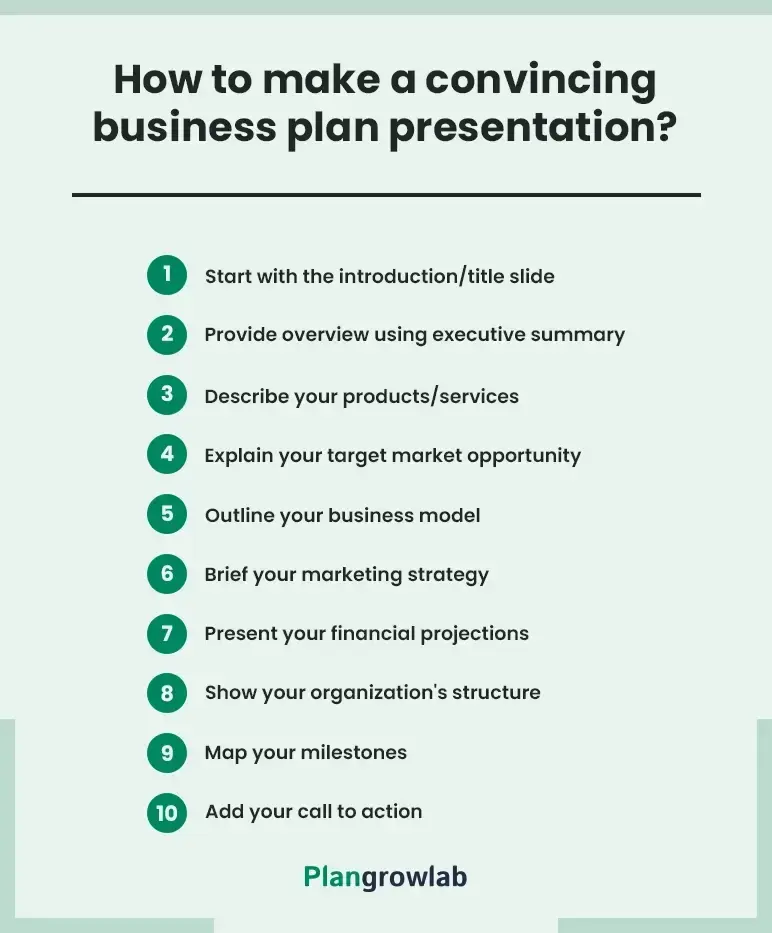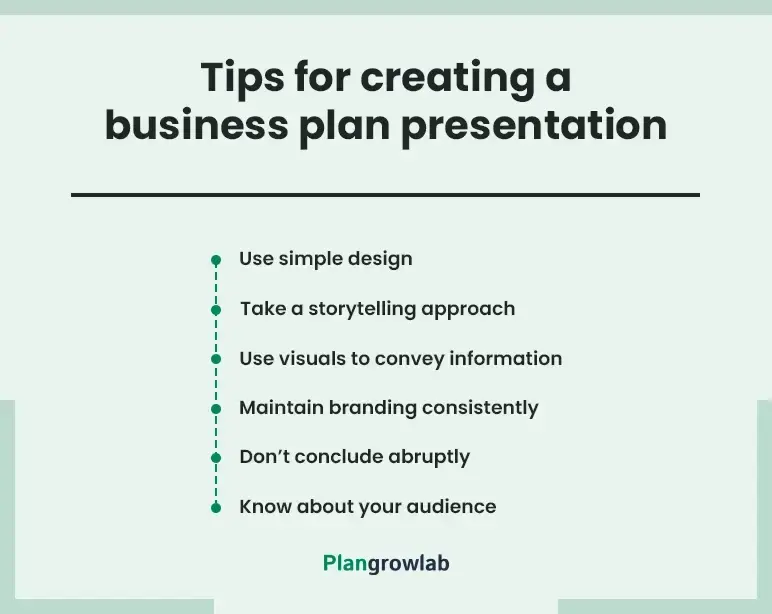Imagine walking into a room of investors with a brilliant business idea—only to lose their attention within the first few slides of the presentation.
Such a scenario usually stems from problems like—overloading your audience with unnecessary details, cluttered slides, and poorly structured content.
You might have a brilliant idea, but without a well-structured and engaging business plan presentation—you’re just another person saying, “Trust me, it’ll work!”
Spoiler alert: That’s not enough to convince your potential investors.
In this article, I’ll help you ditch the confusion and create a business plan presentation that wows your potential investors and gets the job done.
What is a business plan presentation?
A business plan presentation, or pitch deck, is a structured and visual summary of your business idea.
According to Harvard Business School, “The perfect pitch shows investors your proof of concept and instills confidence that they can expect a return on investment.”
Similarly, your business plan presentation aims to prove your idea's feasibility and reassure your audience that their investment will yield results.
It should highlight key aspects such as your business objectives, concept, solution, target market, operations, and strategies in a concise, easy-to-digest format.
Is it worth getting a pitch deck professionally designed?
Well, it depends on your goals and resources. If you pitch to high-stakes investors, a professionally designed pitch deck can give you an edge.
Pitch deck experts bring design, storytelling, and data presentation skills to the table and ensure you have a detailed business plan presentation that’s visually appealing, easy to follow, and impactful.
While DIY solutions may seem cost-effective and a logical choice—they often fail to engage your potential investors and deliver the clarity required. So, if you have the funds, you should consider getting your pitch deck professionally designed—it’s totally worth it.
Let Professionals Design Your Pitch Deck
Partner with an expert writer to develop your pitch deck
Why do you need a business plan presentation?
A business plan presentation offers several advantages, making it a crucial tool for effectively conveying your business strategy and idea. Here’s how it helps:
| Secure funding | Presents a clear financial roadmap, business opportunity, and ROI potential to attract potential investors. |
| Pitch to potential partners | Highlights mutual benefits and growth opportunities to build partnerships and collaborations. |
| Win business plan competitions | Delivers a compelling plan to stakeholders to showcase your innovation and execution potential. |
| Engages key stakeholders | Provides a solid plan to engage board members, team leaders, or advisors to ensure business goals alignment. |
| Attracts potential clients | Positions your business as a credible source and encourages trust and interest. |
| Validates business viability | Showcases market research and financial projections to prove the sustainability of your business strategy. |
What to include in your business plan presentation
Here are the key elements to include in your business plan presentation:
Introduction
Also known as the title slide, it’s the first section that gives a quick overview of your business. Here, include information like business name, logo, tagline, name of the presenter, and contact details.
Problem and solution
A detailed explanation of the problem your target market is facing and the solutions you’ll offer to solve the problems. Introduce your products/services and highlight the competitive edge in the market.
Market analysis
An extended market analysis section of 2-3 slides to convey essential information about your business’s position in your target market. Here, include details like industry overview, business’s competitors, and market position.
Business model and pricing strategy
A comprehensive outline of your business that demonstrates how you would be making money with your business. Here, include details like product/service offerings, revenue model, market demand, competitor pricing, and your pricing strategies.
Traction
A section showcasing the progress and achievements of the business, such as sales milestones, customer acquisition, or partnerships. It demonstrates the business’s credibility and potential based on its track record.
Marketing and sales strategy
A description of the marketing plan as well as strategies and methods to promote the product or service to the target audience. It covers advertising channels, customer retention strategies, and sales tactics to ensure a steady flow of revenue.
Financial projections
A detailed forecast of the financial performance of the business over a specific period. This includes revenue, expenses, profitability, and key financial metrics that investors or stakeholders can review.
Your organization chart
A visual representation of the business’s management team, highlighting key roles and responsibilities. This section often emphasizes the expertise and experience of the leadership team.
Use of funds
A breakdown of essential details about how the requested funding will be used for scaling the business. This section will include categories such as source of funding, product development, marketing, hiring, or operational expenses.
Call to action
A concluding section that summarizes the key takeaways of your business plan and the next steps required from the audience.
How to make a convincing business plan presentation?
Follow this guide step-by-step to understand how to create a business plan presentation:

1. Start with the introduction/title slide
No. of slides: 1
The first slide of your business plan presentation structure will outline the key components of your business to give a quick overview and set the tone for the rest of your presentation.
Include details like business name, logo, tagline, name of the presenter, and contact details so that stakeholders know who to approach for further discussions.
To give more clarity to your stakeholders—you can also include a one-line summary of what your business offers. You can get creative here but don’t extend the summary.
2. Provide overview using executive summary
No. of slides: 1 - 2
Provide an overview of your whole business idea in short and touch upon all the aspects you’ll be covering in the plan. If the idea resonates with your stakeholders, they are likely to pay attention to the rest of the business plan presentation.
Include information like the mission statement, the problems your business plans to solve, your objectives, your competitive advantage, and a brief idea about your business finances and funding requests.
You can use bullet points or short paragraphs to organize information for easy scanning. Try to avoid heavy blocks of text—and complement key points with visuals.
3. Describe your products/services
No. of slides: 2-3
This slide will describe the solutions your product or service will offer to address the target market problems and generate revenue.
Provide an in-depth explanation of what your product or service is, how it works, and what makes it unique and effective. You can also touch on how your offerings generate revenue—but keep it very short here.
If you want to make this concise presentation more effective, include stats, graphs, and quotes to emphasize your point.
4. Explain your target market opportunity
No. of slides: 2-3
Clearly explain your market size, your competitors, your customer base, and market trends as it shows your stakeholders that there’s a demand for your product/service in the market.
Here, include information like competitor analysis, target market, market trends, and your ideal customer persona.
Describe your target audience in detail—like, age, income, location, interests, values, and buying patterns. If possible, segment your audience into primary and secondary customer groups too.
5. Outline your business model
No. of slides: 1-2
This is one of the core slides that will give your stakeholders a clear picture of how your business will generate revenue and be financially stable and profitable going forward.
So, take your time to explain your product, then justify your price point, and lastly why your target customer will opt for your product over your competitors.
Don’t forget to include information like the product pricing, pricing model, revenue streams, and order management process.
6. Brief your marketing strategy
No. of slides: 1-2
The slide shows your potential partner and investors the marketing and sales planning process, including how you will attract, engage, and retain your initial customers.
Here’s your chance to show your stakeholders how you’ll generate leads and convert potential customers into paying customers.
Include information about your marketing and sales strategy—including, channels, brand position, promotional activities, sales tactics, resource allocation, and funnels you’ll use.
7. Present your financial projections
No. of slides: 2-4
The slide outlines your financial goals and growth trajectory to your stakeholders and helps them visualize how you plan to generate revenue, cover expenses, and make profits.
Include details like revenue projections, expense estimates, sales forecasts, income statements, cash flow statements, and balance sheets.
8. Show your organization's structure
No. of slides: 1
Provide a clear view of your organization (preferably using a flowchart). This will help your stakeholders understand the team’s expertise, operational flow, and team’s skills, and show that it’s prepared to scale.
Include details like key personnel names, departments or teams, advisors or board members, and achievements.
9. Map your milestones
No. of slides: 1
This slide will outline your business’s key goals and objectives and the steps you have taken or will take to achieve them.
It shows your potential partners and investors that your business is on track and has achieved measurable success.
Here, include details like short-term goals, long-term goals, past achievements, the timeline decided upon, and the individuals responsible.
10. Add your call to action
No. of slides: 1
In the last slide, put forward what you expect from your audience—whether it’s funding, their support, or a meeting. This is done to ensure the momentum keeps on going after your presentation.
Include details like the next steps, stakeholder benefits, timeline, and contact information.
Tips for creating a business plan presentation
Here are some tips on how to present a business plan to help you impress potential investors:

Use simple design
Keep the design clean and minimal, and keep ample white space. Avoid overloading slides with text—instead, focus on concise phrases that highlight your main points.
Take a storytelling approach
Humans are hardwired to respond to stories. So, instead of simply bombarding with facts and figures—share the backstory of how you developed your solution and help your potential investors relate.
While storytelling is about emotional connection, facts and figures are crucial for credibility—don’t skip them.
Use visuals to convey information
Successful presentations use charts, graphs, and other visual designs to convey your data easily instead of using dense and complicated spreadsheets. However, ensure that there are captions or brief explanations for the context of the visual.
Avoid overloading slides with multiple graphs or charts. Instead, focus on one visual per slide with a clear headline that highlights the essential elements or main takeaways.
Maintain branding consistently
Incorporate your brand’s logo, colors, and fonts across all slides for a cohesive look.
For an impactful presentation, ensure there’s consistency in slide formatting too—align headings, text boxes, and visual elements uniformly—a disorganized layout can distract your audience.
Know about your audience
Research which industry your audience belongs to beforehand—so that you can speak their language and incorporate industry-specific terminologies, trends, or challenges they are likely familiar with.
Don’t conclude abruptly
Avoid ending your presentation abruptly, as it can leave your audience confused or dissatisfied. Instead, take time to recap the key points and tie them back to your business goals and vision.
Business plan presentation examples
Check out these business plan presentation examples from businesses that have already established themselves in the industry and learn how you can also follow in their footsteps:
When LinkedIn entered an already-dominated social media industry, its pitch was simple yet very unique—a network for professionals for career growth and advancement.
However, the real challenge was to prove how this innovative idea could scale into a profitable business going forward—and here’s the pitch deck they used.
Key takeaways from LinkedIn’s successful pitch deck:
- Emphasized LinkedIn’s market position and projected growth with its historical and market research data.
- Used a storytelling approach to establish the founding team despite a lot of information.
- Recognized its target audience right—investors who could also become users and tailored the pitch accordingly.
- Addressed both the “what” (concept) and the “how” (execution) and laid a sustainable roadmap for growth.
- Balanced granular data in a compelling and easy-to-digest format without overwhelming the audience.
The Facebook we see today, and the one that was initially introduced are worlds apart.
Back then, the motto of creating the pitch deck was just to prove that there was a clear scope for expansion in the future. Here’s the pitch deck Facebook used to prove its point.
Key takeaways from Facebook’s pitch deck:
- Articulated Facebook’s market potential and established how the product aligned perfectly with the audience.
- Leveraged data effectively by embedding real metrics and research.
- Laid out a solid plan that connected the product-market fit with future milestones.
Conclusion
We hope this blog has helped you understand how to create the best business plan presentation for your brainchild. A great pitch needs to tell your story clearly and leave a lasting impression.
However, it’s not always easy to master it—that’s why working with expert pitch deck consultants from Plangrowlab can make all the difference.
They know exactly how to highlight your business strengths, present complex data from your business plan in an easy-to-digest format, and design a slide deck that keeps your audience engaged.
In fact, our consultants also have expertise in creating business plans from scratch as well, which you will need because your investors will demand it sooner or later.
So, what are you waiting for? Reach out to our consultants today and create a successful business plan presentation today!
Frequently Asked Questions
Why should I hire professionals for my business plan presentation?
Professionals bring expertise in design, storytelling, and data visualization—which ensures your business plan presentation is persuasive and investor-ready.
How much does a business plan presentation cost?
The cost of a business presentation deck ranges between $2,000 and $25,000. But this can be less or more depending on the complexity, number of slides, and the professional’s expertise.
How long should a business plan presentation be?
A business plan presentation should ideally be concise, lasting about 15-20 minutes. This will be around 10 to 15 slides, and ensure you cover key points without losing the audience’s attention.
What to include in your business plan presentation?
Your presentation should include:
- Introduction
- Problem and solution
- Market analysis
- Business model and pricing strategy
- Traction
- Sales and marketing plan
- Financial projections
- Your organization chart
- Use of funds
- Call to action

